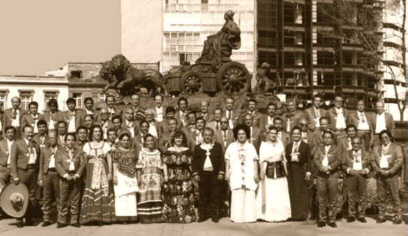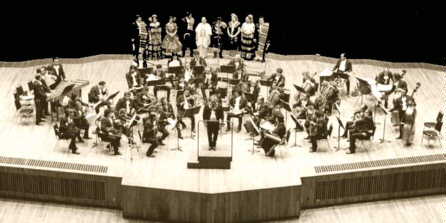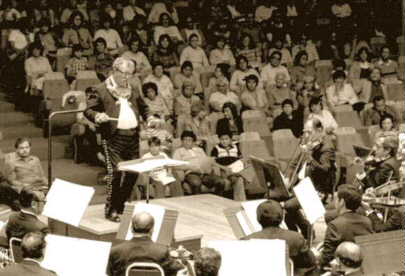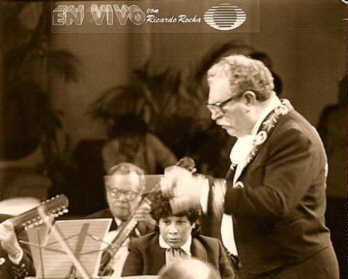![]()
![]()
![]()
![]()
![]()
![]()
![]()
![]()


ANTONIO CASO. México, 1943.
The Mexican Typical Orchestra was a monument in honor of the Mexican musical nationalism".
GERONIMO BAQUEIRO FOSTER.
History of the Music in Mexico, 1964.


OF MEXICO CITY
This music was sung and danced with simple or adorned accompaniment of musical groups, formed by harp, violins, large mandolins, psalteries and large guitars. In the meantime, in the theater stages there were being shown "Spanish sonecitos" and "professional dances" of European taste and flavor, but everything orchestrated and performed by professional musicians and dancers.
By popular demand, the approval of the vice-regal authorities was obtained to alternate at the Gran Teatro (Grand Theater) of the Metropolis the "Spanish sonecitos" with "sonecitos of the country" or "sonecitos of the land". The audience in general, when listening to this music orchestrated and performed by professional musicians identified with the style, wanted to see this music being danced. This was the origin of the "dances of the land", which were meant to represent, together with the "sonecitos" and "jarabitos", the sense of being Mexican, which preceded the fight for Independence.
This repertoire of "dances of the land" came down of the theater stages and joined the "sonecitos" and "jarabitos" being performed out of stage and reached all the groups of harp, guitars, large guitars, violins, psalteries and large mandolins, that were in charge of making it known at the plazas, gardens, markets, neighborhoods, etc., where the distinctly Mexican music was needed as an element of attraction and was received and listened to with great joy.
The production of these musical genders, performed by really typical groups, covered all the XIX Century and the groups gave the basic instrumental equipment which, enlarged by the visiting Spanish student bands, culminated in its orchestral development with the creation of the Typical Orchestra, founded by Carlos Curti on August, 1884, as it appears in the copy of the proceedings issued in "La Prensa" (The Press), on Monday, August 5, 1929.
The first audition of this Typical Orchestra was private and was dedicated to General Porfirio Díaz, then President of the Mexican Republic, who gave the orchestra the name of Mexican Typical Orchestra. The concert was performed on September 20, 1884, at the Conservatory Theater, and as main work it was presented an arrangement of several melodies connected, which Carlos Curti, as its author, called "Aires Nacionales Mexicanos" (Mexican National Tunes). That ensemble of melodies, whose origin was distinctly Mexican, impressed the audience due to its beauty and to the perfection of its execution.
Forty years had gone by since, on February 10, 1844, a remarkable German violoncellist, Maximiliano Bohrer -born in Manheim in 1785- having being invited for the opening of the Santa Ana Theater, played for the first time, as concert work, a Fantasia about Mexican and Spanish "sonecitos", of which he was author. He had entitled it "El Carnaval de México" (Mexico’s Carnival). The performance of this great artist was so impressive by presenting Mexican popular music arranged in that way that, from that moment, many foreign artists visiting Mexico tried to do the same, some of them even wearing the national typical costumes. As an example we have the Viennese pianist and composer Enrique Herz, the English singer Ana Bishop and the dancers Corby and Viethoff, from the Choreographic Company of Hipólito Montplaisir. The young Mexican musicians of that time would take advantage of this instruction.
After a series of public concerts in different places of the Capital, the Mexican Typical Orchestra gave a concert at the Arbeu Theater, dedicated to the Honorable Foreign Colonies and to the Mexican students; this audition, performed on December 3, 1884, and where the success of Carlos Cantu’s arrangement for "Mexican National Tunes" was endorsed, was a farewell one, since the Orchestra had been invited to perform at the New Orleans Universal Expo, where it provoked great admiration due to its originality in all aspects. At the closing of the Expo, it toured some cities of the United States of America and returned to Mexico because Carlos Conti -as well as some members of the Orchestra- had to return to their classes at the Conservatory.
At the end of 1885, the Mexican Typical Orchestra was again organized, but not as a company anymore; on January 8, 1886 they traveled to Zacatecas, where they gave three concerts and they went on to the United States of America, Canada, again to the United States and Cuba, returning to the Mexican Republic on July, 1887, when the Orchestra was dissolved in the city of Puebla.
In 1901, Juan Velázquez, a good musician and bass player, who had accompanied Carlos Curti during his second tour with the Mexican Typical Orchestra, formed a small typical group to perform in a "Zarzuela" that was being represented at the Principal Theater. Because his group sounded so pleasant, it was invited to enliven a party given to D. Manuel Corral, who was then Vice President of the Republic and Secretary of the Ministry of the Interior. Juan Velázquez increased the number of elements in his group to convert it into an orchestra and his performance was very praised.
The musical nationalism of Mexico had its origins in the development of one of the three musical styles which appeared in our Country since 1785; this musical style was the very profuse production of "sonecitos" (popular melodies) and "jarabitos" (mexican folk dance), which were legitimately popular.

 |

Heading his orchestra, Miguel Lerdo de Tejada traveled to Buffalo, N.Y., in July 1901 and returned in October of that same year. In 1904, he performed at the St. Louis Missouri Expo. In 1909 it accompanied General Porfirio Díaz to El Paso, Texas, where the Mexican President had an interview with the U.S.A.’s President, W.H. Taft. In 1910, besides performing with his orchestra at the Centennial festivities, he organized a Ladies’ Typical Orchestra with the same purpose. In 1913, the Typical Orchestra Lerdo de Tejada was given the dress uniform of the Rurals and in 1917, it made its debut at the Chamber Music Room of the Carnegie Hall on March 2, and performed for the second time on April 4 of that same year, in a farewell performance.
In September, 1919, the Typical Orchestra Lerdo de Tejada went on a tour to the north of the Mexican Republic and to some cities of the United States, being the last one Los Angeles, Cal., from where it returned to Mexico at the beginning of 1920. In 1921, Miguel Lerdo de Tejada -who since the former year had been appointed Chief of the Spectacles Office and had instituted the Cultural Council of Mexico City- was appointed Organizer and Conductor of the Centennial Typical Orchestra, that would participate in the festivities to commemorate the consummation of our Independence. In 1923, the Typical Orchestra Lerdo de Tejada made a tour through several states in central Mexico.

 |

In 1928, as a result of a wise coordination among Dr. Manuel Puig Casaurano (who was Public Education Minister), Mr. Morrow (Ambassador of the U.S.A. in Mexico) and Miguel Lerdo de Tejada, taking advantage to the visit of the famous aviator Charles Lindberg to our country, it was possible to organize a tour of the Typical Orchestra Lerdo de Tejada through the U.S.A. and Canada, contracted by the Circuit of American Theaters Keith Albee Orpheum to perform at fifty theaters appertaining to the circuit. The debut of the Orchestra was on February 19, 1928, at the St. Louis Theater in St. Luis Missouri and the last performance at the Keith’s Theater in Syracuse, N.Y., on December 23 of the same year. When the contract was over, the Orchestra stayed in New York making recordings until mid January, 1929, returning to Mexico immediately. Back in Mexico, it stayed there only the necessary time to organize a tour through South America, although, due to several reasons, it was only able to visit the republics of Guatemala and San Salvador, returning to Mexico immediately.
In November, 1929, being President of the Republic Lic. Emilio Portes Gil, and being Governor of Mexico City Dr. Manuel Puig Casauranc, by Presidential Decree it was created the Police Typical Orchestra under the conduction of Miguel Lerdo de Tejada. From its creation until 1932, inclusive, the Orchestra performed in Mexico City and in close states of the Mexican Republic, but in 1933 and 1934 it accompanied Gral. Lázaro Cárdenas in his presidential campaign, although reduced in the quantity of its elements. In 1935 the Police Typical Orchestra traveled to Washington, D.C. and in 1936 to New York, San Diego and Los Angeles.
In 1938, between March 19 and November 30, the Police Typical Orchestra traveled to Oakland, Stoponi, San Francisco, Los Angeles, Tucson, Portland and Seattle in the U.S.A. and to the Guatemalan Republic. In October, 1939, the Orchestra performed at the Dallas Fair and on Tuesday, November 14 of that same year, it went to Guatemala to perform at the Annual Expo being carried out there.
On March 6, 1940, the Orchestra traveled to Chile. Since neither Miguel Lerdo de Tejada nor Pablo Marín could join them, who were titular Conductor and Sub-Conductor of the same, the President of the Republic, Gral. Lázaro Cardenas, through the Governor of Mexico City, appointed Mario Talavera as Provisional Sub-Conductor of the Typical Orchestra of Mexico City. This was through mediation of Lic. Luciano Kubli, who was head of the Civic Action General Direction and who had a sincere friendship with Miguel Lerdo de Tejada and Mario Talavera. It is probably in this year, 1940, when the name of the Police Typical Orchestra changed to Typical Orchestra of Mexico City. On May 26 of that same year, after having obtained a great success in each one of the stages of the tour, they found upon their return in their country, all the elements that formed the Typical Orchestra of Mexico City.
Composer Miguel Lerdo de Tejada, Conductor of the Typical Orchestra formed by Juan Velázquez in 1901, and which was successively transformed into Lerdo de Tejada Typical Orchestra, Police Typical Orchestra and finally into Typical Orchestra of Mexico City, died at 5:00 p.m. on May 25, 1941, when he was 72 years old. Due to his own merits, Maestro Pablo Marín was appointed by the Authorities of the Central Office as his successor, who was titular Sub-Conductor of the Orchestra since 1929. Magnificent musician and fervent in love with the Mexican music, he enriched the repertoire of the Typical with a great number of arrangements and some compositions of his own. Upon his death, in 1960, Maestro Jesús Corona was appointed as Provisional Conductor; he was contemporary of Miguel Lerdo de Tejada and Titular Sub-Conductor when Pablo Marín was Conductor. He lasted a short time in this position. In that same year, being elected by Lic. Ernesto P. Uruchurtu -Governor of the City-, the internationally renowned composer Ignacio Fernández Esperón (Tata Nacho) is appointed for the titular position and Maestro Jesús Corona returns to the Sub-Direction.
Composer Ignacio Fernández Esperón created a new position of Sub-Conductor to be held by Félix Santana, also a great arranger musician, who performed this task until his death in 1972, working hard and increasing the repertoire of the Typical with a series of musical arrangements very well achieved.
When Tata Nacho died, in 1968, Maestro Jesús Corona was again in charge of the Conduction of the Typical Orchestra of Mexico City, but this time as titular. This appointment was ratified by the authorities of the Central Office, although, due to his age, he almost delegated all the musical activity in Félix Santana and in a young musician, Maestro Jesús Galarza Acosta, who succeeded him in the position as Provisional Conductor in April, 1975, date when Maestro Jesús Corona retired.
In April, 1977, the Comisión Mixta de Escalafón (Scale Mixed Commission) of the Central Office intervenes for the first time in the history of the Typical Orchestra of Mexico City and subjects the designation of the Titular Conductor to a contest. Participants in this contest were the Sub-Conductors of the Orchestra, Maestros Delio Solís Alvarado and Daniel Zarabozo Gutiérrez, being the winner, by unanimous verdict of the Jury, Daniel Zarabozo Gutiérrez

 |

After the period when the Orchestra had great governmental support and acknowledgment abroad, the authorities reduced its importance until the position of Conductor was held through contest by Daniel Zarabozo, who takes again the spirit of Miguel Lerdo de Tejada to give the Orchestra back its splendor, as well as its national and international reputation. A lot was advanced but he could not fulfill all his plans due to governmental policies and to the lack of the social and political relations that Miguel Lerdo de Tejada had, so right after Daniel Zarabozo’s retirement, the Orchestra fell into forgetfulness and into the political appointment of its Conductors.
Maestros José Antonio Zavala and Armando Zayas have been, to this date, Daniel Zarabozo’s successors in the position of Conductor.
In the 117 years of existance of the Typical Orchestra, and among its few Conductors and Sub-Conductors, Daniel Zarabozo has been one of the few members of this Orchestra who has had complete knowledge and interest with respect to the Mexican music.

Following, a list can be found of Conductors and Sub-Conductors (titular and provisional) that The Typical has had.
CARLOS CURTI
JUAN VELAZQUEZ
MIGUEL LERDO DE TEJADA
JUAN TORREBLANCA
MIGUEL LERDO DE TEJADA
PABLO MARIN
JOSE BRISEÑO
ALFONSO ESPARZA OTEO
MARIO TALAVERA
IGNACIO FERNANDEZ ESPERON (TATA NACHO)
FELIX SANTANA
JESUS CORONA
JESUS GALARZA
DANIEL ZARABOZO

 |

ARMANDO ZAYAS

"Serenata"... Daniel Zarabozo
© 1996
 Raúl Zarabozo
Raúl Zarabozo




Reserved copyrights on the music contained in this page:
© 1994
Raúl Zarabozo E. de R Background music of this page:

Musical arrangements:

